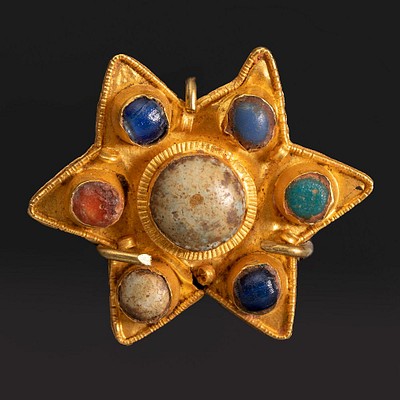ACISCLO ANTONIO PALOMINO Y VELÁSCO (Bujalance, Córdoba, 1655 - Madrid, 1726). "The Circumcision of Christ". Oil on canvas.
Lot 85
About Seller
Setdart Auction House
Carrer Aragó 346
Barcelona
Spain
Setdart Subastas was born in 2004 and is currently the first online art auction in Spain with solidity, prestige and reliability guaranteed by our more than 60,000 users. Setdart has a young, dynamic and enterprising team ready to successfully manage the purchase and sale of art works through custom...Read more
Estimate:
EUR€6,000 - EUR€7,000
$6,315.79 - $7,368.42
Absentee vs Live bid
Two ways to bid:
- Leave a max absentee bid and the platform will bid on your behalf up to your maximum bid during the live auction.
- Bid live during the auction and your bids will be submitted real-time to the auctioneer.
Bid Increments
| Price | Bid Increment |
|---|---|
| EUR€0 | EUR€10 |
| EUR€200 | EUR€25 |
| EUR€500 | EUR€50 |
| EUR€1,000 | EUR€100 |
| EUR€3,000 | EUR€200 |
| EUR€5,000 | EUR€500 |
| EUR€10,000 | EUR€1,000 |
| EUR€20,000 | EUR€2,000 |
| EUR€50,000 | EUR€5,000 |
About Auction
By Setdart Auction House
Dec 21, 2021
Set Reminder
2021-12-21 07:30:00
2021-12-21 07:30:00
America/New_York
Bidsquare
Bidsquare : Córdoba: 2,000 Years of Art
https://www.bidsquare.com/auctions/setdart-auction-house/c-rdoba-2-000-years-of-art-8049
Setdart Auction House sofia@setdart.com
Setdart Auction House sofia@setdart.com
- Lot Description
ACISCLO ANTONIO PALOMINO Y VELÁSCO (Bujalance, Córdoba, 1655 - Madrid, 1726). "The Circumcision of Christ". Oil on canvas. Presents restorations and has a period frame. Measurements: 83 x 105 cm; 123 cm (frame). It is the Evangelist Luke who narrates this episode (2, 21), being a usual iconographic theme in all the Christian tradition, and that precedes the Presentation of the Child in the Temple. The art is helped by the information provided by the Apocryphal Gospels (Pseudo-Matthew, Arabic Gospel of the infancy, mainly) to add details to the theme that, in Are, is shown since the end of the 10th century, usually forming part of the Cycle of Mary or of Christ. The present work has a relatively simple background to focus the viewer's attention on the figures, although it has been ennobled by a series of moldings and hanging draperies, recalling Baroque works. The figures, shown almost from the waist up, create a balanced composition around the central element: the altar where the Child Jesus is, with the priest who is going to circumcise him. Mary also appears, with the usual colors in her iconography in this century. Classicism is evident in the anatomy of the figures, the lack of strong light and chromatic contrasts, the expressions of the characters, etc., although the survival of details of the 17th century Baroque tradition is also clear, as is usual in the Spanish school of the time on some occasions. Due to its characteristics of style and form, we can relate this work to the hand of Acisclo Antonio Palomino, painter and one of the most outstanding Baroque art treatises. Palomino trained in Córdoba under the direction of Juan de Valdés Leal. He traveled to Madrid in 1678, and there he was introduced into the circle of Carreño de Miranda and Claudio Coello, who brought him into contact with the royal collections and gave him the opportunity to produce his first works for the court, which allowed him to obtain the title of painter to the king in 1688. The arrival of Lucas Jordán in Madrid in 1692 made him interested in the fresco technique, becoming one of the most important Spanish fresco painters of the second half of the 17th century. Between 1697 and 1701 he worked in Valencia, and in 1705 he traveled to Salamanca to carry out a religious commission. Between 1712 and 1713 he painted a series of canvases with scenes and saints related to the history of Cordoba for the cathedral, and between 1723 and 1725 he worked on what would be his last work, the decoration of the tabernacle of the Carthusian monastery of El Paular in Granada. Ordained a priest when he was widowed in 1725, he is now especially known as a writer and art theorist, thanks to his work "El museo pictórico y escala óptica" (1715-24). Palomino is widely represented in the Prado Museum, as well as in numerous Spanish churches and museums throughout Spain.
- Shipping Info
-
In-house shipping available. Please inquire at admin@setdart.com.
-
- Buyer's Premium



 EUR
EUR CAD
CAD AUD
AUD GBP
GBP MXN
MXN HKD
HKD CNY
CNY MYR
MYR SEK
SEK SGD
SGD CHF
CHF THB
THB

















